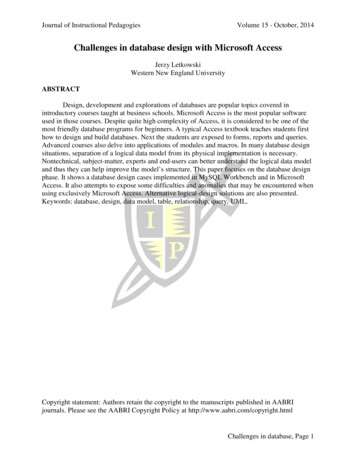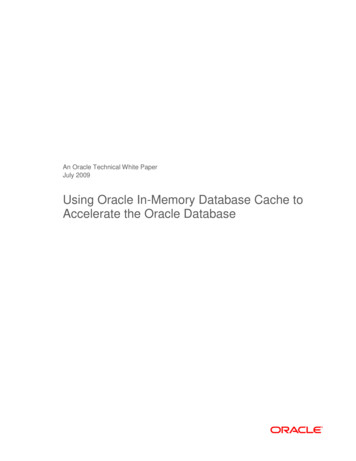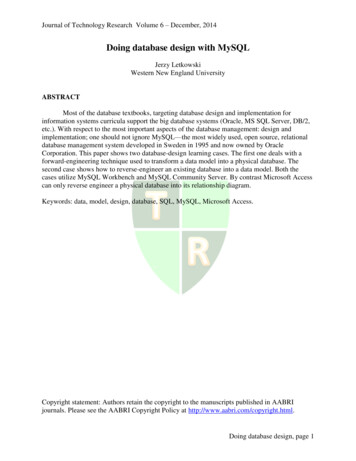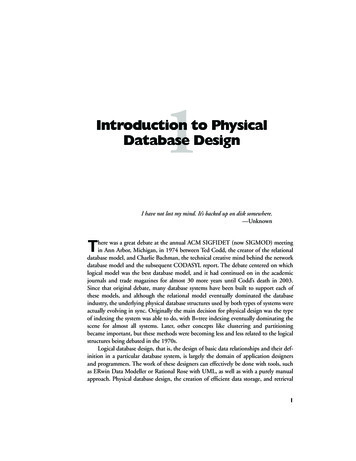
Transcription
Journal of Instructional PedagogiesVolume 15 - October, 2014Challenges in database design with Microsoft AccessJerzy LetkowskiWestern New England UniversityABSTRACTDesign, development and explorations of databases are popular topics covered inintroductory courses taught at business schools. Microsoft Access is the most popular softwareused in those courses. Despite quite high complexity of Access, it is considered to be one of themost friendly database programs for beginners. A typical Access textbook teaches students firsthow to design and build databases. Next the students are exposed to forms, reports and queries.Advanced courses also delve into applications of modules and macros. In many database designsituations, separation of a logical data model from its physical implementation is necessary.Nontechnical, subject-matter, experts and end-users can better understand the logical data modeland thus they can help improve the model’s structure. This paper focuses on the database designphase. It shows a database design cases implemented in MySQL Workbench and in MicrosoftAccess. It also attempts to expose some difficulties and anomalies that may be encountered whenusing exclusively Microsoft Access. Alternative logical-design solutions are also presented.Keywords: database, design, data model, table, relationship, query, UML.Copyright statement: Authors retain the copyright to the manuscripts published in AABRIjournals. Please see the AABRI Copyright Policy at http://www.aabri.com/copyright.htmlChallenges in database, Page 1
Journal of Instructional PedagogiesVolume 15 - October, 2014DATABASE DESIGN PROCESSA typical database design process involves requirement analysis, conceptual (high level)design, and logical design—all leading to a physical design (Elmasri, at al., 2004, p. 51). Thefinal logical data model should be specific enough in order to be mapped onto a physicaldatabase. As shown, for example, in (Letkowski, 2014), a data model—developed as anEnhanced Entity Relationship Diagram (EERD) in MySQL Workbench—can be automaticallytransformed into a physical design (database schema). Such a model includes a complete set ofentities, attributes, key, relationships, cardinality and participation constraints that are necessaryto accurately define a physical database (Silberschatz, at al., 2001, p. 27-37).Building a data model (EERD), using systems like MySQL Workbench, depends more onthe subject-matter (domain) expertise than on the database skills. A subject-matter expert, whounderstands simple concepts of an entity (or class) and relationship can decidedly contribute todevelopment of the data model. The following example shows a simulated scenario1 of thedatabase design process with two participants: a domain expert (a sales manager, “Mark”) anddatabase expert (a database administrator, “Debbie”).Mark: “I have been managing my sales for quite some time, using a phone and spreadsheetbased ordering system. Recently, I have read some interesting articles about how my job can beimproved by switching to a Web based system.”Debbie: “You understand that a Web system requires a multiuser and concurrent access to yourdata! Thus you can’t use your spreadsheet program. You would have to move to a databasesolution.”Mark: “Yes, I have read about that too. Can you help me with designing a database? I’d like tosee, for example, how basic information about customers, orders and products can be stored inthe database.”Debbie: “Absolutely! Could you briefly explain how your system works? At this stage, let’s usfocus on capturing and modeling information about orders.”Mark: “It is quite simple. We maintain a list of customers and products. Our customers placeorders from time to time. We make sure that each order belongs to one and only one customer.The orders include some of our products—mainly small pieces of furniture (desks, chairs,shelves, etc.). Each product may be part of many orders.”Debbie: “I get it! Would you agree that your basic data entity sets (or object sets) are: Customer,Order and Product?Mark: “Indeed they are! As a matter of fact they are already maintained in our current system asspreadsheet lists. Our customers are mainly businesses so we store ‘name’, ‘addresses’, contactinformation (‘phone’, ‘fax’, and ‘email’). Our orders includes ‘order date’ and reference to thecustomers who placed them (‘cid’). Finally, our products are characterized using such propertiesas ‘description’, ‘finish’, ‘unit price’, and ‘quantity on hand’. ”Debbie: “Great! You can also say that they (entity sets) are organized as tables. If so, they willbe organized in a database in almost the same way—as database tables. We have to make surethat all rows in the tables are unique. To this end, for each table, we will create an identifier that,as you probably know, is referred to as a Primary Key (PK).”Mark: “I thought it would be much harder. In fact, we use integers to identify particular rows inthe spreadsheet tables so we could easily look up relevant data, for example, when generatinginvoices. Our identifiers are: ‘cid’ (customer ID), ‘poid’ (Order ID), and ‘pid’ (Product ID).”1This scenario is loosely based on the Pine Valley Furniture case presented in (Hoffer, at al., 2005 p. 63-70).Challenges in database, Page 2
Journal of Instructional PedagogiesVolume 15 - October, 2014Debbie: “Outstanding! Indeed, a spreadsheet lookup procedure comes very close to what werefer to in a database as a relationship. Later, in the database, you will be able to generateinvoices by just using relationships, speaking of which, you have already mentioned the mostimportant ones. Let me formalize them, using already established entity sets, as: Customer(1) – places – Order(1.n) Order(0.n) – includes – Product(1.n) “Mark: “I kind of get it but not entirely.Debbie: “The first relationships is of type ‘one-to-many’. As you mentioned, a customer mayplace one or many orders (1.n). In the same time, each order belongs to one (1) and only onecustomer. The second relationship is of type ‘many-to-many’. One order may include manyproducts (1.n) and one product may be part of zero or many orders (0.n). These entities andrelationships plus the attributes you mentioned above are all we need to construct a data model—the so called Entity Relationship Diagram (ERD). I will show you how to do it, using the 2014version of MySQL Workbench2. The first step is to define the basic entities: Customer, Orderand Product. Start MySQL workbench, create a new EERD model and, using the Table tool addthe three entities, providing their names and attributes. Make sure that each entity has its own PK(Primary Key). Figure 1 shows the resulting diagram. Notice that, contrary to a spreadsheetimplementation, each of the attributes must have appropriate type. The generic types (INT,FLOAT, DATETIME) are obvious. VARCHAR and CHAR stand for text types. The formerspeciffies the maximum size (capacity) and the latter—the exact size. Next, the relationshipsbetween the entities must be defined. They are a reflection of business. The Customer - Orderrelationship is created, using a Non-Identifying, One-To-Many relationship (1:n) by andconnecting entity Order with entity Customer. A new attribute is added automatically to entityOrder: Customer cid (Figure 2).”Mark: “Why is the Non-Identifying Relationship used here? What does it mean? “Debbie: “Both the entities (Customer and Order) are already identified by their primary keys(cid, and poid). The additional field, Customer cid, added to entity Order does not uniquelyidentify any order. It simply points to the customers that ‘own’ the orders.”Mark: “It makes sense. What about the new attribute, Customer cid? It looks like a copy of theprimary key ‘cid’ in entity (table) Customer. In our spreadsheet implementation we use a similarapproach in order to be able to lookup customer information in our invoices.”Debbie: “Indeed it acts like a copy. Such an attribute is called a Foreign Key (FK). Its role is tomake sure that each order ‘knows’ its owner. One can also say that each order matches (Harkins,2004) its customer. In addition, the database system should ensure that each value of thisattribute is one of the values of the related primary key, ‘cid’ defined in table Customer. Thiskind of validation is referred to as Referential Integrity. It is also important to note that this newkey, Customer cid, is strictly connected to the relationship between entities Order and Customer.Removing the key will also remove the relationship (connection line) and vice versa.” It is veryimportant to understand that a foreign key only exists in the context of a relationship. It is aproperty of an entity (table) whose instances (records) depend on or are spawn by an instance ofthe related entity. With respect to the Customer – Order relationship, a customer places (creates)one or more orders. Each order is ‘signed’ by one customer. This signature is represented by theforeign key.”2A complete (detail) procedure for developing a data model (EERD), using MySQL Workbench is shown in(Letkowski, 2014).Challenges in database, Page 3
Journal of Instructional PedagogiesVolume 15 - October, 2014Mark: “OK, I got it! The PK-FK pairs reflect particular relationship instances which arise frombusiness operations (rules). I could say that the role of the Primary Key is to maintain the EntityIntegrity and the role of the Foreign Key is to ensure the Referential Integrity.”Debbie: “Very important points! Unlike spreadsheets, databases help us maintain data integrity.Out next step is to take care of the second relationship (Order – Product). This time we will use aMany-to-Many Relationship tool (‘n:m’). There is only one version of this tool: the IdentifyingRelationship. When two entities are connect with this tool, a new entity is spawned as shown inFigure 3. This is a so called associative entity. It may not exist on its own. Both the entities,Order and Product, are needed for this new entity to exist. Its business role is to ‘know’ whichproduct is part of which order. It is frequently described as an order detail, invoice line, or orderline. We will use the latter (OrderLine) to name this new entity.”Mark: “This all sound reasonable. I can see that we are almost there. There is one extra piece ofinformation missing. We should not forget to add the ‘order quantity’, or just ‘quantity’ to thisnew entity.”Debbie: “Excellent! This is why domain experts should always participate in database designprocesses. Like nobody else, they know the business rules and can anticipate what informationwill be needed in order to perform all sorts of business operations and decisions. To wrap up ourdesign, let us rename the new entity and new attributes. I would also recommend to renameentity Order to PurchaseOrder. Some systems, like MySQL, do not accept user defined namesthat coincide with reserved word (e.g. Order). Figure 4 shows the final version of the model. ”Mark: “So now, how do we convert this model into a ‘real’ database?”Debbie: “With MySQL, we can automatically generate the database structure or what it isknown in the database ‘world’ as the database schema. This is why the model, we have justcreated, is called an ‘Enhanced’ Entity Relationship Diagram3.”DESIGNING A DATABASE IN ACCESS USING SQLUsing the data model, like the one shown in Figure 4, a database expert should be able todevelop manually appropriate SQL - CREATE TABLE statements that would create thedatabase schema. MySQL Workbench can generate such statements automatically from theEERD model4. The resulting statements are fully compatible the MySQL database system:CREATE TABLE IF NOT EXISTS Customer ( cid INT NOT NULL, name VARCHAR(100) NOT NULL, address VARCHAR(100) NULL DEFAULT NULL, city VARCHAR(40) NULL DEFAULT NULL, state CHAR(2) NULL DEFAULT NULL, zip VARCHAR(20) NULL DEFAULT NULL,PRIMARY KEY ( cid ));ENGINE InnoDB;CREATE TABLE IF NOT EXISTS Product ( pid INT NOT NULL, description VARCHAR(200) NULL DEFAULT NULL, finish VARCHAR(50) NULL DEFAULT NULL, unitPrice FLOAT NULL DEFAULT NULL,3The EERD examples, included in this paper, show the logical data model implemented in UML. Since manydatabase developers also develop applications, using Object-Oriented language it is convenient for them to expressthe model, using the Object-Oriented design language—UML (Naiburg, Maksimchuk, 2001).4It can be done by means of menu options (commands): Database Forward Engineer (Letkowski 2014).Challenges in database, Page 4
Journal of Instructional PedagogiesVolume 15 - October, 2014 onHand INT NULL,PRIMARY KEY ( pid ))ENGINE InnoDB;CREATE TABLE IF NOT EXISTS PurchaseOrder ( poid INT NOT NULL, poDate DATETIME NULL DEFAULT NULL, cid INT NOT NULL,PRIMARY KEY ( poid ),CONSTRAINT fk Order Customer FOREIGN KEY ( cid )REFERENCES Customer ( cid )ON DELETE NO ACTIONON UPDATE NO ACTION)ENGINE InnoDB;CREATE TABLE IF NOT EXISTS OrderLine ( pid INT NOT NULL, poid INT NOT NULL, quantity INT NULL,PRIMARY KEY ( pid , poid ),CONSTRAINT fk Product has Order Product1 FOREIGN KEY ( pid )REFERENCES Product ( pid )ON DELETE NO ACTIONON UPDATE NO ACTION,CONSTRAINT fk Product has Order Order1 FOREIGN KEY ( poid )REFERENCES PurchaseOrder ( poid )ON DELETE NO ACTIONON UPDATE NO ACTION)ENGINE InnoDB;Microsoft Access can execute such statements but it does not accept the followingtokens: ‘IF NOT EXISTS’, ‘ENGINE InnoDB’, ‘DEFAULT NULL’, ‘ON DELETE NOACTION’, and ‘ON UPDATE NO ACTION’. After removing these token in a text editor, theremaining SQL code can be executed in the SQL (Data Definition) panel of the Queryenvironment in Access. Each of the create-table statements must be executed separately. Figure 5shows execution the last of the following SQL statements:CREATE TABLE Customer ( cid INT NOT NULL, name VARCHAR(100) NOT NULL, address VARCHAR(100) NULL, city VARCHAR(40) NULL, state CHAR(2) NULL, zip VARCHAR(20) NULL,PRIMARY KEY ( cid ));CREATE TABLE Product ( pid INT NOT NULL, description VARCHAR(200) NULL, finish VARCHAR(50) NULL, unitPrice FLOAT NULL, onHand INT NULL,PRIMARY KEY ( pid ));CREATE TABLE PurchaseOrder (Challenges in database, Page 5
Journal of Instructional PedagogiesVolume 15 - October, 2014 poid INT NOT NULL, poDate DATETIME NULL, cid INT NOT NULL,PRIMARY KEY ( poid ),CONSTRAINT fk Order Customer FOREIGN KEY ( cid ) REFERENCES Customer ( cid ));CREATE TABLE OrderLine ( pid INT NOT NULL, poid INT NOT NULL, quantity INT NULL,PRIMARY KEY ( pid , poid ),CONSTRAINT fk Product has Order Product1 FOREIGN KEY ( pid ) REFERENCES Product ( pid ),CONSTRAINT fk Product has Order Order1 FOREIGN KEY ( poid ) REFERENCES PurchaseOrder ( poid ));The resulting Relationships diagram (Figure 6) is similar to the original data model(Figure 4). Access shows all cardinality constraints but without the participation constraints. Forexample, according to the original model the participation of entity OrderLine in the OrderLine –Product relationship is optional. This detail is not revealed in Access. This relationship is shownin Access as OrderLine( ) – Product(1) whereas in the original model it is defined as OrderLine(0.n) – gets – Product(1) . Here, symbols ‘ ’and ‘n’ both stand for‘many’.Another interesting aspect of the Relationships diagram in Access is that the relationshipsare not firmly coupled with their foreign keys. For example, contrary to the MySQL Workbenchmodel, removing a relationship does not remove the foreign key standing behind the relationship.Adding records to Access tables via SQL is somewhat challenging. Only one SQL-Insertstatement can be executed at a time in the SQL–Query panel. A macro command is needed to runmultiple SQL-Insert statements. The following VBA code will execute sequentially all SQLstatements contained in a plain-text document, sql.txt, stored in directory C:\db:Sub BatchSQL()Dim fileRef As IntegerDim txtSqlStatements As StringDim sqlStatmentList As VariantDim sqlStatement As VariantfileRef FreeFile()Open "C:\db\sql.txt" For Input As #fileReftxtSqlStatements Input(LOF(fileRef), #fileRef)Close fileRefsqlStatmentList Split(txtSqlStatements, ";")On Error Resume NextFor Each sqlStatement In sqlStatmentListCurrentDb.Execute sqlStatementNextEnd SubHaving all the tables populated with data, Access is now ready for applications. Thephone based ordering system can benefit from more friendly and reliable input forms. Relevantinformation can be quickly retrieved using queries. Finally, the management can benefit fromperiodically generated reports. However, these problems go beyond the scope of this paper. Theyare exhaustively addressed, for example, in (Adamski, at al., 2011) and (Poatsy, at al., 2014).Challenges in database, Page 6
Journal of Instructional PedagogiesVolume 15 - October, 2014DESIGNING A DATABASE IN ACCESS USING THE GUITeaching database concepts and applications in business curricula is typically driven bytutorial based instructions provided by popular textbooks like (Adamski, at al., 2011) or (Poatsy,at al., 2014), utilizing mainly the GUI environment of Microsoft Access.Students learn first how to build database tables. They are not exposed to design issuesextensively. Typically, they are brought directly into physical databases, learning technicalaspect of navigating in a maze of menus, toolbars, dialog panels, and other Windows widgets.For example, (Adamski, at al., 2011, p. AC1-AC48) starts with Tutorial 1, “Creating aDatabase”. The students are introduced to basic database terminology, including notion of‘field’, ‘table’, ‘database’, ‘primary key’, ‘foreign key’, and ‘relationship’. They also learn in thistutorial how to develop a simple ‘query’, ‘form’, and ‘report’. The concept of a relationship isexplained by means of the primary key and the foreign key. A similar approach is shown in(Poatsy, at al., 2014, p. 83-140). The students first learn how to use an existing database byperforming simple sorting and filtering operations, next they are introduced to relational databaseissues where relationships are explained again, using the primary and foreign keys.It is beyond the scope of this paper to show all details of the database developmentprocess performed with the Graphical User- Interface (GUI) in Access. (Adamski, at al., 2011)and (Poatsy, at al., 2014) do it thoroughly. Additional instructive materials can also be retrieveddirectly from Microsoft (MS Access – Guide, 2014), (MS Access – Relationship, 2014).However it is important to notice that the Access-GUI based process is not entirely consistentwith the common system development process. This process, as shown in the previous section(DESIGNING A DATABASE IN ACCESS USING SQL), adheres to the principles andstructure of the system development life cycle (SDLC) involving a sequence of tasks such as(Hoffer, at al., p.46):1. Identification2. Initiation and Planning3. Analysis4. Logical Design5. Physical Design6. Implementation7. MaintenanceIn Access, steps 4 and 5 are intertwined or somewhat reversed. Given a fully developedlogical data model for a relational database should include both the entity and referentialintegrity features, as shown, for example, in (Figure 4), such a model can’t be developed inAccess without first building a physical database. More over this model must (up front) includeall necessary foreign keys. Figure 7 shows a ‘Design View’ for table PurchaseOrder. Thepid and poid fields play two roles. They define both the primary key of the table and theforeign keys, linking this table to tables Product and PurchaseOrder, respectively. At thisstage, this table definition is equivalent to the following SQL statement:CREATE TABLE OrderLine ( pid INT NOT NULL, poid INT NOT NULL, quantity INT NULL,PRIMARY KEY ( pid , poid ));Challenges in database, Page 7
Journal of Instructional PedagogiesVolume 15 - October, 2014Moreover, the foreign keys, pid and poid, kind of exist but they are not formallyacknowledged or marked up as such. By contrast, the MySQL Workbench design (Figure 4)shows the PurchaseOrder entity with all its bells and whistles, identifying explicitly therelationships and producing a physical table that is fully compliant with both the entity andreferential integrity rules:CREATE TABLE OrderLine ( pid INT NOT NULL, poid INT NOT NULL, quantity INT NULL,PRIMARY KEY ( pid , poid ),CONSTRAINT fk Product has Order Product1 FOREIGN KEY ( pid ) REFERENCES Product ( pid ),CONSTRAINT fk Product has Order Order1 FOREIGN KEY ( poid ) REFERENCES PurchaseOrder ( poid ));In order to bring this and other tables to the same status in Access, a ‘Relationships’ diagrammust be completed. Figure 8 shows an initial diagram with all the database [physical] tablesincluded. For the foreign keys to become the first class citizens, they must be linked with theirrespective primary keys. Figure 9 shows the final phase for completing the logical and physicaldesign. The primary key, pid, of the Product table is dragged-and-dropped onto (linked to)the foreign key, pid, of the OrderLine table and the ‘Enforce Referential Integrity’ option ischecked. All other relationships are defined in a similar way. The database is ready forapplication development (queries, forms, reports, etc.).CONCLUSIONSThe entire GUI based database design process leads to the same result as the MySQLWorkbench one (Figures 6 and 9). However, it is important to note a subtle difference betweenthese two ways. The EER diagram tool of MySQL Workbench uses relationships to generateforeign keys. It also is capable of generating associative entities when many-to-manyrelationships are being resolved. The resulting model is fully compliant with the entity andreferential integrity constraints. On the other hand, the GUI tools in Access require a physicaldatabase that already satisfies the entity integrity constraints. Finally, by developing theRelationships diagram, the database becomes 100% relational.Between Microsoft Access and MySQL Workbench, the latter seems to be better suitedfor database design consistent with the System/Software Development Life Cycle (SDLC)process (Wikipadia - SPD 2015). Moreover, developing an ERD with MySQL Workbench hasadditional advantages. The ERD can be expressed in many notations, including UML (Wikipadia- SPD 2015) which arguably has the most capable tools to fully support the SDLC (Naiburg,Maksimchuk, 2015, p. 10). Figure 10 shows an ERD developed in UML, sing one of the initialversions of Rational Rose. What is very significant about this ERD is that it does not show anyforeign keys. It is as pure a design as it gets. Obviously the foreign keys are buried behind therelationships. The following SQL script, generated by Rational Rose, defines a proper databasescheme (including the foreign keys):Challenges in database, Page 8
Journal of Instructional PedagogiesVolume 15 - October, 2014CREATE TABLE T Customer(cid int() NOT NULL,name VARCHAR(100),address VARCHAR(100),city VARCHAR(40),state VARCHAR(20),zip VARCHAR(20),PRIMARY KEY(cid))CREATE TABLE T PurchaseOrder(poid int() NOT NULL,poDate DateTime(),cid int() NOT NULL,FOREIGN KEY (cid) REFERENCES T Customer,PRIMARY KEY(poid))CREATE TABLE T Product(pid int() NOT NULL,description VARCHAR(200),finish VARCHAR(50),unitPrice float(),onHand int(),PRIMARY KEY(pid))CREATE TABLE T OrderLine(quantity int(),poid int() NOT NULL,FOREIGN KEY (poid) REFERENCES T PurchaseOrder,pid int() NOT NULL,FOREIGN KEY (pid) REFERENCES T Product,OrderLineId NUMBER(5),PRIMARY KEY(OrderLineId))No matter which design tools is used, an intriguing question remains. Should businessstudents learn how to design databases according to the SDLC process? The current approachseems to be some sort of prototyping—a method of the Rapid Application Development (RAD)approach. The SDLC process is more methodical and better structured and, generally,prototyping requires a higher level of database expertise (Hoffer, at al., 2004, p.48). One wouldsuppose that the SDLC process should be given more consideration especially in businesscurricula for at least two reasons. First, typically, at the learning time, the students are beginners.Second, after graduation they are more likely to become domain rather than database experts andthus they may have more opportunities to participate in database design activities rather than indatabase application development duties.Challenges in database, Page 9
Journal of Instructional PedagogiesVolume 15 - October, 2014REFERENCESAdamski, J. J., Finnegan. K. T. (2011). New Perspectives on Microsoft Access 2010, Brief.Boston: Course Technology - Cengage Learning.Elmasri, R., Navathe, S. B. (2004). Fundamentals of Database Systems. Boston: Pearson /Addison Wesley.Harkins, S. (2004). Define relationships between database tables. TechRepublic. Retrievedfrom: nships-between-database-tables/Hoffer, J. A, Prescott, M. B., McFadden, F. R. (2005). Modern Database Management, SeventhEdition. Upper Saddle River, New Jersey: Pearson - Prentice Hall.Letkowski, J. (2014). Doing database design with MySQL. Journal of Technology Research.ISSN Online: 1941-3416 (http://www.aabri.com/jtr.html) Volume 6.MS Access - Relationship (2014). Create, edit or delete a relationship. Retrieved -a128-fdebc7e686afMS Access - Guide (2014). Guide to table relationships. Retrieved 6fb812b58fNaiburg, E.J., Maksimchuk, R. J. (2001). UML for Database Design. Boston: Addison Wesley.Poatsy, M. N., Krebs, C., Cameron, E., Williams, J., Grauer, R.T. (2014). Exploring: MicrosoftAccess 2013, Comprehensive. Boston: Pearson Education, Inc.Silberschatz, A., Korth, H. F., Sudarshan S. (2001), Database System Concepts. Boston:Osborne/McGraw-Hill.Wikipadia - SPD (2015). Software development process. Retrieved from:http://en.wikipedia.org/wiki/Software development processWikipadia - UML (2015). Unified Modeling Language. Retrieved from:http://en.wikipedia.org/wiki/Unified Modeling LanguageChallenges in database, Page 10
Journal of Instructional PedagogiesVolume 15 - October, 2014APPENDIXFigure 1. The basic components (entities) of the data model. A new table is created using the NewTable tool.Figure 2. Connecting entity (table) Order with Customer. A foreign key, Customer cid, is addedautomatically to table Order.Challenges in database, Page 11
Journal of Instructional PedagogiesVolume 15 - October, 2014Figure 3. Resolving a Many-to-Many relationship. The ‘n:m’ tool connects entities Product andOrder.Figure 4. A data model (EERD) of a product ordering system.Challenges in database, Page 12
Journal of Instructional PedagogiesVolume 15 - October, 2014Figure 5. Executing SQL- Create Table statement in a Data Definition panel, in Access.Figure 6. The Relationship diagram of the database in Access.Challenges in database, Page 13
Journal of Instructional PedagogiesVolume 15 - October, 2014Figure 7. Defining table PurchaseOrder in Access.Figure 8. The initial phase of developing a Relationships diagram in Access (a collection ofunlinked tables).Challenges in database, Page 14
Journal of Instructional PedagogiesVolume 15 - October, 2014Figure 9. Defining a relationship between database entities (tables) and enforcing thereferential integrity in Access.Figure 10 An ERD developed in UML, using Rational Rose.Challenges in database, Page 15
This paper focuses on the database design phase. It shows a database design cases implemented in MySQL Workbench and in Microsoft Access. It also attempts to expose some difficulties and anomalies that may be encountered when using exclusively Microsoft Access. Alternative logical-design solutions are also presented. Keywords: database, design .










